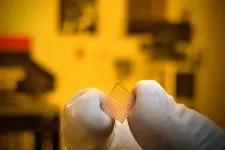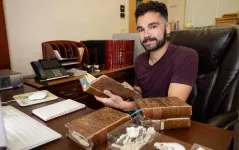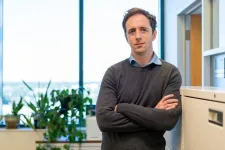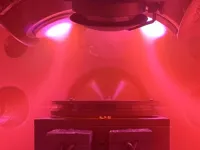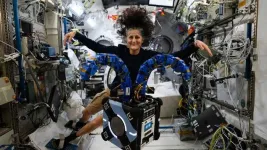(Press-News.org) As computer chips continue to get smaller and more complex, the ultrathin metallic wires that carry electrical signals within these chips have become a weak link. Standard metal wires get worse at conducting electricity as they get thinner, ultimately limiting the size, efficiency, and performance of nanoscale electronics.
In a paper published Jan. 3 in Science, Stanford researchers show that niobium phosphide can conduct electricity better than copper in films that are only a few atoms thick. Moreover, these films can be created and deposited at sufficiently low temperatures to be compatible with modern computer chip fabrication. Their work could help make future electronics more powerful and more energy efficient.
“We are breaking a fundamental bottleneck of traditional materials like copper,” said Asir Intisar Khan, who received his doctorate from Stanford and is now a visiting postdoctoral scholar and first author on the paper. “Our niobium phosphide conductors show that it’s possible to send faster, more efficient signals through ultrathin wires. This could improve the energy efficiency of future chips, and even small gains add up when many chips are used, such as in the massive data centers that store and process information today.”
A new class of conductors
Niobium phosphide is what researchers call a topological semimetal, which means that the whole material can conduct electricity, but its outer surfaces are more conductive than the middle. As a film of niobium phosphide gets thinner, the middle region shrinks but its surfaces stay the same, allowing the surfaces to contribute a greater share to the flow of electricity and the material as a whole to become a better conductor. Traditional metals like copper, on the other hand, become worse at conducting electricity once they are thinner than about 50 nanometers.
The researchers found that niobium phosphide became a better conductor than copper at film thicknesses below 5 nanometers, even when operating at room temperature. At this size, copper wires struggle to keep up with rapid-fire electrical signals and lose a lot more energy to heat.
“Really high-density electronics need very thin metal connections, and if those metals are not conducting well, they are losing a lot of power and energy,” said Eric Pop, the Pease-Ye Professor in the School of Engineering, a professor of electrical engineering, and senior author on the paper. “Better materials could help us spend less energy in small wires and more energy actually doing computation.”
Many researchers have been working to find better conductors for nanoscale electronics, but so far the best candidates have had extremely precise crystalline structures, which need to be formed at very high temperatures. The niobium phosphide films made by Khan and his colleagues are the first examples of non-crystalline materials that become better conductors as they get thinner.
“It has been thought that if we want to leverage these topological surfaces, we need nice single-crystalline films that are really hard to deposit,” said Akash Ramdas, a doctoral student at Stanford and co-author on the paper. “Now we have another class of materials – these topological semimetals – that could potentially act as a way to reduce energy usage in electronics.”
Because the niobium phosphide films don’t need to be single crystals, they can be created at lower temperatures. The researchers deposited the films at 400 degrees Celsius, a temperature that is low enough to avoid damaging or destroying existing silicon computer chips.
“If you have to make perfect crystalline wires, that’s not going to work for nanoelectronics,” said Yuri Suzuki, the Stanley G. Wojcicki Professor in the School of Humanities and Sciences, a professor of applied physics and co-author on the paper. “But if you can make them amorphous or slightly disordered and they still give you the properties you need, that opens the door to potential real-world applications.”
Enabling future nanoelectronics
Although niobium phosphide films are a promising start, Pop and his colleagues don’t expect them to suddenly replace copper in all computer chips – copper is still a better conductor in thicker films and wires. But niobium phosphide could be used for the very thinnest connections, and it paves the way for research into conductors made of other topological semimetals. The researchers are already looking into similar materials to see if they can improve niobium phosphide’s performance.
“For this class of materials to be adopted in future electronics, we need them to be even better conductors,” said Xiangjin Wu, a doctoral student at Stanford and co-author on the paper. “To that end, we are exploring alternative topological semimetals.”
Pop and his team are also working on turning their niobium phosphide films into narrow wires for additional testing. They want to determine how reliable and effective the material could be in real-world applications.
“We’ve taken some really cool physics and ported it into the applied electronics world,” Pop said. “This kind of breakthrough in non-crystalline materials could help address power and energy challenges in both current and future electronics.”
For more information
Pop is also professor, by courtesy, of materials science and engineering in the School of Engineering and of applied physics in the School of Humanities and Sciences. He is the faculty co-director of Stanford SystemX and a senior fellow of the Precourt Institute for Energy.
Suzuki is also professor, by courtesy, of materials science and engineering in the School of Engineering and is the director of Stanford Nano Shared Facilities and a member of Stanford Bio-X.
Additional Stanford co-authors of this research are Krishna Saraswat, the Ricky/Nielsen Professor in the School of Engineering; Felipe H. da Jornada, assistant professor of materials science and engineering; and graduate student Emily Lindgren.
Other co-authors of this work are from Ajou University, Korea Electronics Technology Institute, and IBM T.J. Watson Research Center.
This work was funded by the National Science Foundation, the Precourt Institute for Energy, the SystemX Alliance, the Stanford Graduate Fellowship, and the National Research Foundation of Korea.
END
A new ultrathin conductor for nanoelectronics
2025-01-08
ELSE PRESS RELEASES FROM THIS DATE:
Synthetic chemicals and chemical products require a new regulatory and legal approach to safeguard children’s health
2025-01-08
Chestnut Hill, Mass (01/08/2025) – Nations must start testing and regulating chemicals and chemical products as closely as the current systems that safeguard prescription drugs or risk rising rates of chronic illnesses among children, according to a New England Journal of Medicine report by a group of experts writing as the Consortium for Children’s Environmental Health.
Global chemical inventories contain an estimated 350,000 products – such as manufactured chemicals, chemical ...
The genes that grow a healthy brain could fuel adult glioblastoma
2025-01-08
FOR IMMEDIATE RELEASE
Media Contact: Levi.Gadye@ucsf.edu, (415) 502-6397
Subscribe to UCSF News
The discovery of a new type of stem cell in the brain could usher in better treatments for the deadliest brain tumor.
UCSF scientists have discovered a stem cell in the young brain that’s capable of forming the cells found in tumors. The breakthrough could explain how adult brain cells take advantage of developmental processes to instigate the explosive growth seen in deadly brain cancers like glioblastoma.
They made the discovery while taking a broad genomic survey of human brain ...
New MSU study explains the delayed rise of plants, animals on land
2025-01-08
EAST LANSING, Mich. – If you like the smell of spring roses, the sounds of summer birdsong and the colors of fall foliage, you have the stabilization of the ozone layer to thank for it. Located in the stratosphere where it shields the Earth from harmful ultraviolet radiation, the ozone layer plays a key role in preserving the planet’s biodiversity.
Now, we may have a better idea of why that took more than 2 billion years to happen.
Michigan State University researcher Dalton Hardisty contributed to a new Yale University-led study finding that Earth’s early atmosphere hosted a battle royal between ...
UTA becomes one of largest natural history libraries
2025-01-08
Thanks to in-kind donations of tens of thousands of rare books, scientific journals, and articles, and reports over the past two years, The University of Texas at Arlington’s Amphibian and Reptile Diversity Research Center (ARDRC) has become one of the largest publicly accessible herpetology libraries in the world.
“Thanks to 12 independent donors, including the Joseph Rex Dinardo Jr. Herpetology and Natural History Science Research Trust in Philadelphia, Dr. Jonathan Campbell, William Lamar, Drs. Jay and Rebecca Savage, and Louis Porras, we now have thousands ...
Number of autistic individuals enrolled in Medicaid and receiving federal housing support increased by 70% from 2008-16
2025-01-08
Affordable and stable housing is critical to improving health across a person's lifespan. People with disabilities, including autism, comprise a significant share of people in need of housing assistance. However, the intersection of housing and health among individuals with autism is largely unknown because data on public housing and public health are not connected. Researchers from Drexel University’s A.J. Drexel Autism Institute examined how many autistic people in the United States received housing ...
St. Jude scientists create scalable solution for analyzing single-cell data
2025-01-08
Researchers have amassed vast single-cell gene expression databases to understand how the smallest details impact human biology. However, current analysis methods struggle with the large volume of data and, as a result, produce biased and contradictory findings. Scientists at St. Jude Children’s Research Hospital created a machine-learning algorithm capable of scaling with these single-cell data repositories to deliver more accurate results. The new method was published today in Cell Genomics.
Before single-cell analysis, bulk gene expression data ...
What is the average wait time to see a neurologist?
2025-01-08
MINNEAPOLIS – Older people wait an average of just over a month to see a neurologist for specialty care after being referred by their primary care physician or another physician, according to a study published in the January 8, 2025, online issue of Neurology®, the medical journal of the American Academy of Neurology. The study, which looked at people who have Medicare insurance, also found some people wait more than three months to see a neurologist.
“Neurologists provide important and ongoing care for people ...
Proximity effect: Method allows advanced materials to gain new property
2025-01-08
UNIVERSITY PARK, Pa. — Ferroelectrics are special materials with polarized positive and negative charges — like a magnet has north and south poles — that can be reversed when external electricity is applied. The materials will remain in these reversed states until more power is applied, making them useful for data storage and wireless communication applications.
Now, turning a non-ferroelectric material into one may be possible simply by stacking it with another ferroelectric material, according to a team led by scientists from Penn State who demonstrated the phenomenon, called proximity ferroelectricity.
The ...
LJI researchers shed light on devastating blood diseases
2025-01-08
LA JOLLA, CA—Scientists at La Jolla Institute for Immunology (LJI) have discovered how a mutated gene kicks off a dangerous chain of events during blood cell production.
The study, published recently in the Proceedings of the National Academy of Sciences, reveals how a mutated gene called ASXL1 is involved in a disease called clonal hematopoiesis, a precursor to malignant diseases such as myeloid malignancies and chronic monomyelocytic leukemia.
"We know that many diseases—and all cancers—are driven by mutations in the genome," says LJI Instructor Zhen Dong, ...
ISS National Lab announces up to $650,000 in funding for technology advancement in low Earth orbit
2025-01-08
KENNEDY SPACE CENTER (FL), January 7, 2025 – The International Space Station (ISSInternational Space Station) National Laboratory is soliciting flight concepts for technology advancement that utilizes the space-based environment of the orbiting laboratory. This solicitation, “Technology Advancement and Applied Research Leveraging the ISS National Lab,” is open to a broad range of technology areas, including chemical and material synthesis in space, translational medicine, in-space edge computing, and in-space servicing, assembly, and manufacturing. It also encompasses the application of space station remote sensing data to improve geospatial analytics ...
